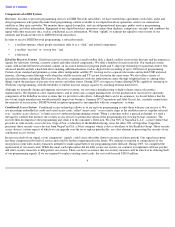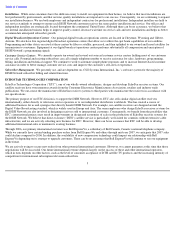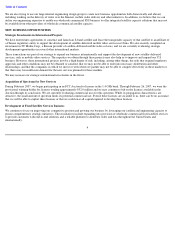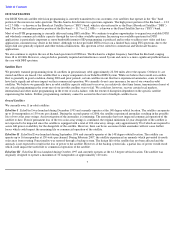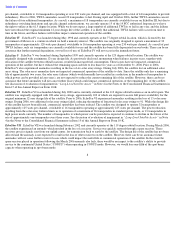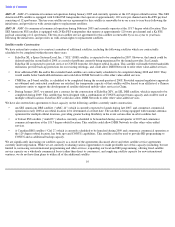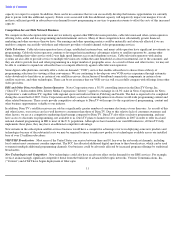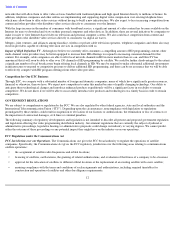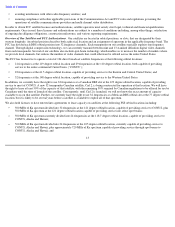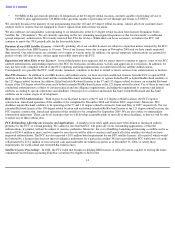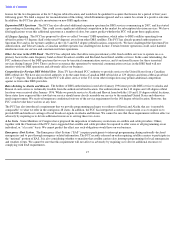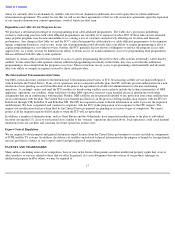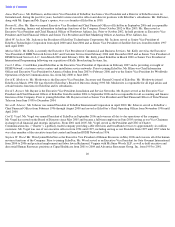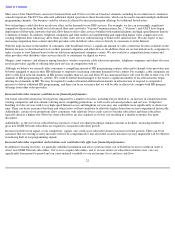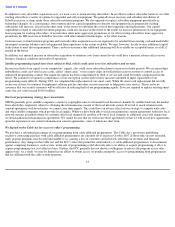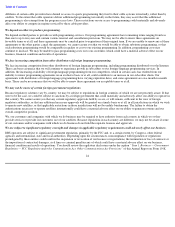Dish Network 2007 Annual Report Download - page 21
Download and view the complete annual report
Please find page 21 of the 2007 Dish Network annual report below. You can navigate through the pages in the report by either clicking on the pages listed below, or by using the keyword search tool below to find specific information within the annual report.
Table of Contents
We currently broadcast the majority of our programming from the 110 and 119 degree orbital locations. Almost all of our customers have
satellite receiver systems that are equipped to receive signals from both of these locations.
We also sublease six transponders (corresponding to six frequencies) at the 61.5 degree orbital location from licensee Dominion Video
Satellite, Inc. (“Dominion”). We are currently operating on the two remaining unassigned frequencies at that location under a conditional
special temporary authorization. We recently renewed that STA for 60 days. While there can be no assurance, we believe the FCC will
continue to renew this STA periodically for the foreseeable future.
Duration of our DBS Satellite Licenses
. Generally speaking, all of our satellite licenses are subject to expiration unless renewed by the FCC.
The term of each of our DBS licenses is 10 years. Two of our licenses were due to expire in November 2006 and we have timely requested
their renewal. Our other licenses are currently set to expire at various times. In addition, our special temporary authorizations are granted for
periods of only 180 days or less, subject again to possible renewal by the FCC.
Opposition and other Risks to our Licenses . Several third parties have opposed, and we expect them to continue to oppose, some of our FCC
satellite authorizations and pending requests to the FCC for extensions, modifications, waivers and approvals of our licenses. In addition, we
may not have fully complied with all of the FCC reporting and filing requirements in connection with our satellite authorizations.
Consequently, it is possible the FCC could revoke, terminate, condition or decline to extend or renew certain of our authorizations or licenses.
Our FSS Licenses . In addition to our DBS licenses and authorizations, we have received conditional licenses from the FCC to operate FSS
satellites in the Ka-band, the Ku-band and the extended Ku-band, including licenses to operate EchoStar IX (a hybrid Ka/Ku-band satellite) at
the 121 degree orbital location. In addition, EchoStar holds Ka-band licenses at the 97 and 113 degree orbital locations, an extended Ku-band
license at the 109 degree orbital location and a hybrid extended Ku/Ka-
band license at the 121 degree orbital location. Use of these licenses and
conditional authorizations is subject to certain technical and due diligence requirements, including the requirement to construct and launch
satellites according to specific milestones and deadlines. Our projects to construct and launch Ku-band, extended Ku-band and Ka-band
satellites are in various stages of development.
Risks to our FSS Authorizations
. With respect to our Ka-band licenses at the 97 and 113 degrees orbital locations, the FCC requires
construction, launch and operation of the satellites to be completed by December 2008 and October 2009, respectively. Moreover, ITU
deadlines require Ka-band satellites to be operating at the 97 and 113 degree orbital locations by June and May of 2007, respectively. For our
extended Ku-band license at the 109 degree orbital location and our hybrid extended Ku/Ka-band license at the 121 degree orbital location, the
FCC requires construction, launch and operation of the satellites to be completed by September 2009. We are also subject to intermediate
construction milestones. There can be no assurance that we will develop acceptable plans to meet all of these deadlines, or that we will be able
to utilize any of these orbital slots.
FCC Rulemaking Affecting our Licenses and Applications . A number of our other applications have been denied or dismissed without
prejudice by the FCC, or remain pending. We cannot be sure that the FCC will grant any of our outstanding applications, or that the
authorizations, if granted, will not be subject to onerous conditions. Moreover, the cost of building, launching and insuring a satellite can be as
much as $250.0 million or more, and we cannot be sure that we will be able to construct and launch all of the satellites for which we have
requested authorizations. The FCC has also imposed a $3.0 million bond requirement for our FSS satellite licenses, all or part of which would
be forfeited by a licensee that does not meet its diligence milestones for a particular satellite. We have provided the FCC with letters of credit,
collateralized by $15.2 million of our restricted cash and marketable investment securities as of December 31, 2006, to satisfy these
requirements for our Ka-band and extended Ku-band licenses.
Satellite License Proceedings
. In 2004, the FCC ruled that businesses holding DBS licenses at orbital locations capable of serving the entire
continental United States (including EchoStar) would not be eligible to bid for the
14
• 500 MHz of Ku spectrum divided into 24 frequencies at the 85 degree orbital location, currently capable of providing service to
CONUS, plus approximately 720 MHz of Ka spectrum capable of providing service through spot beams to CONUS.


